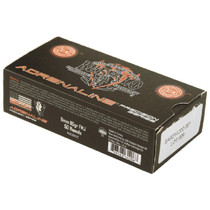Legal Brief: Factoring Criteria for Firearms with Attached Stabilizing Braces
Posted by Cory Ross on Feb 8th 2023

Overview: Legal Brief is a series where the ins and outs, the dos and don’ts of the firearms world are covered. From popular topics to more niche subject matters, the Legal Brief tries to help our reader be the best gun owner out there. Venture Out is an Ohio based outdoor social channel, so therefore most of our articles, videos, and posts, lean towards that fact. Legal Brief is no exception. The things discussed here are geared towards Ohioans. Please, if residing in a different state, follow all the laws and regulations regarding that state. Furthermore, Venture Out is not legal counsel. So please, if you have further questions, seek the appropriate legal authorities on the subject.
On January 31st, the long-awaited ATF ruling on pistol braces was posted to the Federal Register, officially starting the clock on a 120-day grace period to comply with the new regulation. What does this mean for you, the responsible, law-abiding gun owner? First and foremost, the new ruling retracts nearly a dozen years of consistent approval from the ATF that stabilizing braces, like the ones from SB tactical, were legal, and NOT subject to regulation by the NFA. For those that aren’t aware, the NFA—National Firearm Act—is the governing legislature on items such as machine guns, destructive devices, short-barreled rifles and shotguns, and suppressors. For a detailed look at the origins and history of the NFA, see the Venture Out Article: “Legal Brief: Origins of the NFA.” Recently, the ATF conducted a series of “trainings” and “Q&A” sessions with licensed dealers and manufacturers that were aimed to help, but actually, muddled the water further. Straight answers were not given, ignorance to our nation’s history and the function of our government was obvious, and above all, the lack of empathy towards the millions of law-abiding gun owners was blatant.
There has been a lot of discourse explaining the processes and options involved to “comply” with the new ruling. Our goal here at Venture Out is to go further and break down exactly what the ATF is doing and what is prompting this change. First, this is not a law in the normal understanding. The ATF is a bureaucracy of the Executive branch, and therefore does not have the power or right to make laws—that belong to Congress. As such, the ATF is calling this a ruling. Since the ATF has power that is derived from BOTH the Department of Treasury (hence, why they can charge a fee for a “Tax Stamp”) and the Department of Justice, they have power to make rulings on pre-existing laws. Both the National Firearms Act and Gun Control Act were first enacted by Congress and have fallen to the ATF for enforcement, explanation, and definition.
What it is: “Factoring Criteria for Firearms with Attached Stabilizing Braces” changes the original definition from 2012, when the ATF approved the original brace design. In “their” belief, “numerous weapons equipped with stabilizing braces were manufactured and distributed that were different from the 2012 prototype, many of which did intend the weapon to be fired from the shoulder.” Yes, the ATF ruled something was legal, then the industry responded and sold millions of them. So here is a break down from the ruling. It is long—we are sure to miss things. However, this is what we have deemed as important for those following this closely. (This information is from a publicly available PowerPoint presentation. Click here).
First, here is the ruling as written by the ATF:
27 CFR § 478.11 and 27 CFR § 479.11 both define the term “rifle” as:
(1) For purposes of this definition, the term “designed or redesigned, made or remade, and intended to be fired from the shoulder” shall include a weapon that is equipped with an accessory, component, or other rearward attachment (e.g., a “stabilizing brace”) that provides surface area that allows the weapon to be fired from the shoulder, provided other factors, as described in paragraph (2), indicate that the weapon is designed, made, and intended to be fired from the shoulder. When a weapon provides surface area that allows the weapon to be fired from the shoulder, the following factors shall also be considered in determining whether the weapon is designed, made, and intended to be fired from the shoulder.
Those other factors listed include whether the weight or length of the weapon is consistent to rifles designed to be shouldered and whether the length of pull is consistent with those same type of rifles. Furthermore, the type of sight or optic on the gun, the operating system of the firearm (i.e. if it requires a buffer tube), the manufacturers marketing, and (our favorite) information demonstrating the “likely” use of the weapon in the general community. A few things here that cause concern—well all of it does. First, what is surface area? The ruling doesn’t clearly define it with dimensions, so does this fall under the know it when you see it ruling? Likewise, weight and length are listed as factoring criteria, but no numbers are given to quantify what that is. The understanding follows as: if it looks like a shoulder-fired rifle, then it is a shoulder fired rifle. The ambiguity and utter lack of deference to the law is striking. This makes the rule open ended and allows for interpretation by a court. As for sights, if iron sights or a magnified optic with “eye relief” is added and can only be used if the firearm is shouldered, this then transforms the firearm as one intended to be fired from the shoulder. This next point is interesting. Early inquiries thought that the presence of a buffer table, though needed for proper functioning, had enough surface area that it might fall within ATF’s determining parameters. The opposite happened: “An AR-type pistol with a standard 6 to 6-1/2 inch buffer tube may not be designed and intended to be fired from the shoulder even if the buffer tube provides surface area that allows the firearm to be shoulder fired because it is required for the cycle of operations of the weapon.” The picture example used in ATF’s presentation shows a buffer tube with foam wrapped around the end. Presumably this would be legal, though, legality isn’t a known commodity when it comes to ATF rulings.
Finally, the ATF’s final two criteria include people and manufacturers, not the firearm itself. The ATF is looking at the marketing and general “community” consensus on how a firearm is to be used to make determinations of what the firearm should be classified as. So yes, how people post on social media, or discuss them on YouTube will now have legal impact on the determination of firearms. All of this over a piece a rubber that attaches on a metal tube.
Purpose: Now that we’ve gone through the so called “factoring criteria,” that leads to the question: why? Since 2012, the ATF has upheld its original ruling and has allowed stabilizing braces that differed from the original to be manufactured and sold without fault. The answer is simple. The ATF was asked to. The ATF is in the executive branch which falls under the purview of the President, his cabinet, and advisers. In a recent Whitehouse post on Instagram, Golden State Warriors head coach, Steve Kerr, and player, Stephen Curry, met with President Biden about recent gun control measures in California. In the video, President Biden and Kerr lock arms. The President states he banned assault weapons once and he will do it again. (IG video was released on January 18). All of this is an articulated and well calculated attack on an individual’s rights. Starting with the Safer Communities Act and President Biden’s series of Executive Orders that came in the summer of 2021, the current administration has been eroding the rights of the Second Amendment. However, they have done it by not banning guns. No, they have slowly done it by putting pressure on licensed dealers, by increasing the background check period for those 18-20 years old, and by limiting the accessories that an individual can put on a gun. This is a slow constriction on the Second Amendment.
What’s Next: So, for someone that owns one of these devices, what do you do? Well, the designated grace period to register the firearms in question free of penalty and, as an added bonus, with the waiver of the $200 registration fee is between January 31st and May 31st. Otherwise, the braces must be removed and destroyed or reconfigure the pistol into a rifle. Other options include forfeiture and destruction of the firearm, which is not even logical for gun owners. Currently there is a multitude of lawsuits and congressional bills in place to fight this attack. Do your due diligence and support those fighting. Call or write to your congressmen (or women) and Senators. Support organizations such as FRAC, Gun Owners of American, and the Firearms Policy Coalition. If this is upheld, don’t be surprised if the government and ATF go after more. Magazine capacity limits could be in the near future.
 | |
 |  |









